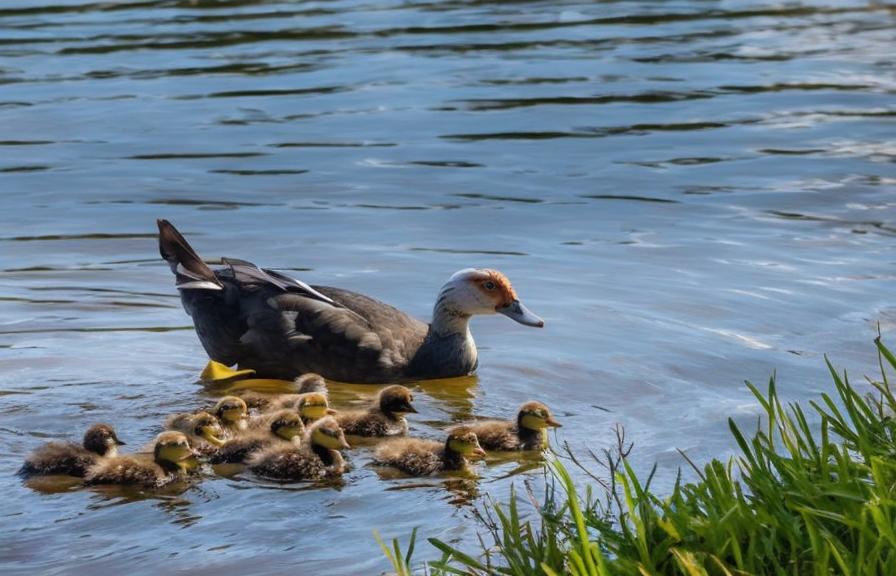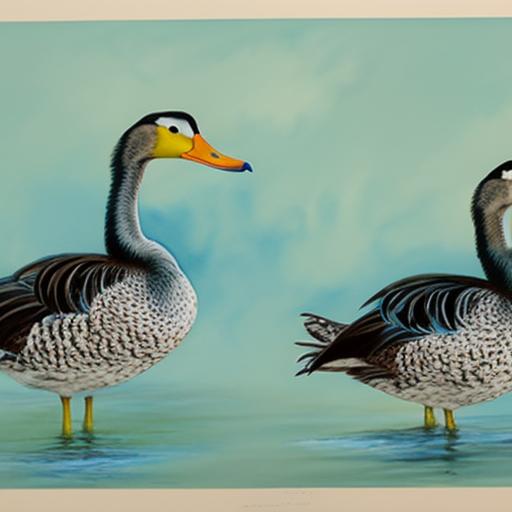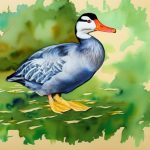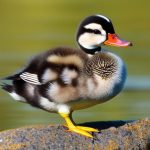Runner ducks are a unique and fascinating breed of domestic duck known for their upright and distinctive posture. They are a popular choice for both backyard hobbyists and commercial farmers due to their excellent egg-laying abilities, foraging skills, and pest control capabilities. Runner ducks are also known for their comical and entertaining behavior, making them a delightful addition to any farm or homestead. There are several different breeds of runner ducks, each with its own unique characteristics and traits. In this article, we will explore the various runner duck breeds, their history, characteristics, uses, and care requirements.
Key Takeaways
- Runner ducks are a unique breed known for their upright posture and distinctive running gait.
- They are a lightweight breed with long, slender bodies and are excellent foragers.
- Popular breeds of runner ducks include the Indian Runner, Khaki Campbell, and Penciled Runner.
- Runner ducks have a long history, originating in Southeast Asia and being brought to Europe in the 1800s.
- Care and maintenance of runner ducks include providing a suitable living environment, proper nutrition, and regular health checks.
Characteristics of Runner Ducks
Runner ducks are easily recognizable by their upright stance and slender, athletic build. They have long necks, narrow heads, and a distinctive upright posture that sets them apart from other duck breeds. Runner ducks come in a variety of colors, including white, fawn, black, chocolate, and blue. They are known for their excellent foraging abilities and are often used to control pests in gardens and orchards. Runner ducks are also prolific egg layers, with some breeds laying up to 300 eggs per year. They are relatively low maintenance and can thrive in a variety of environments, making them an ideal choice for both small-scale and commercial duck farming operations.
Runner ducks are also known for their friendly and sociable nature, making them a popular choice for families and hobbyists. They are generally docile and easy to handle, making them suitable for children and novice duck owners. Runner ducks are also highly adaptable and can thrive in both free-range and confined environments. They are excellent foragers and can help control pests such as slugs, snails, and insects in the garden. Their upright posture and unique waddling gait make them a comical and entertaining addition to any farm or homestead.
Popular Breeds of Runner Ducks
There are several popular breeds of runner ducks, each with its own unique characteristics and traits. The most common breeds include the Fawn and White Runner, the Chocolate Runner, the Black Runner, and the Blue Runner. The Fawn and White Runner is perhaps the most well-known and popular breed of runner duck. They have a fawn-colored body with a white bib and underbelly. The Chocolate Runner is similar in appearance to the Fawn and White Runner but has a rich chocolate-colored plumage. The Black Runner has a sleek black plumage, while the Blue Runner has a striking blue-gray coloration.
Each breed of runner duck has its own unique egg-laying capabilities, foraging skills, and temperament. The Fawn and White Runner is known for its excellent egg-laying abilities, while the Chocolate Runner is prized for its richly colored plumage. The Black Runner is valued for its pest control capabilities, while the Blue Runner is admired for its striking coloration. Regardless of the breed, runner ducks are generally easy to care for and make an excellent addition to any farm or homestead.
History and Origins of Runner Duck Breeds
The exact origins of runner ducks are not well-documented, but it is believed that they originated in Southeast Asia, particularly in the region that is now Indonesia. Runner ducks were first introduced to Europe in the 19th century and quickly gained popularity for their excellent egg-laying abilities and pest control capabilities. Over time, several different breeds of runner ducks were developed, each with its own unique characteristics and traits.
The Fawn and White Runner is believed to be one of the oldest breeds of runner duck, with records dating back to the 1800s. The Chocolate Runner, Black Runner, and Blue Runner were developed later as breeders sought to create new color variations of the popular Fawn and White Runner. Today, runner ducks are found all over the world and are valued for their versatility, adaptability, and entertaining behavior.
Care and Maintenance of Runner Ducks
Runner ducks are relatively low maintenance and can thrive in a variety of environments. They require access to fresh water for swimming and bathing, as well as a balanced diet that includes a combination of commercial duck feed, grains, vegetables, and insects. Runner ducks should be provided with adequate shelter to protect them from predators and inclement weather. They also require regular access to outdoor space for foraging and exercise.
It is important to provide runner ducks with a safe and secure environment to prevent predation from foxes, raccoons, birds of prey, and other potential threats. Additionally, regular health checks and preventative measures should be taken to ensure the well-being of runner ducks. This includes regular deworming, vaccinations, and access to veterinary care when needed.
Runner ducks are generally sociable and do well in small flocks. They should be provided with ample space to roam and access to fresh water for swimming and bathing. It is important to provide adequate protection from extreme temperatures, predators, and other potential hazards. With proper care and maintenance, runner ducks can live long and healthy lives while providing valuable contributions to the farm or homestead.
Uses of Runner Ducks

Runner ducks have several practical uses on the farm or homestead. They are valued for their excellent egg-laying abilities, with some breeds laying up to 300 eggs per year. Their eggs are nutritious and delicious, making them a valuable addition to the farm or kitchen. Runner ducks are also excellent foragers and can help control pests such as slugs, snails, insects, and weeds in the garden or orchard.
In addition to their practical uses, runner ducks are also valued for their entertaining behavior and comical antics. They are known for their friendly and sociable nature, making them a popular choice for families and hobbyists. Runner ducks can also be trained to perform simple tricks or tasks, adding an element of fun and entertainment to the farm or homestead.
Conclusion and Considerations for Choosing a Runner Duck Breed
In conclusion, runner ducks are a unique and versatile breed of domestic duck that is valued for their excellent egg-laying abilities, foraging skills, pest control capabilities, and entertaining behavior. There are several different breeds of runner ducks, each with its own unique characteristics and traits. When choosing a runner duck breed, it is important to consider factors such as egg-laying capabilities, coloration, temperament, and intended use.
Regardless of the breed chosen, runner ducks are generally low maintenance and easy to care for. They thrive in a variety of environments and make an excellent addition to any farm or homestead. With proper care and maintenance, runner ducks can provide valuable contributions to the farm while also providing entertainment and enjoyment for the whole family. Whether you are a commercial farmer or a backyard hobbyist, runner ducks are an excellent choice for anyone looking to add a unique and practical addition to their farm or homestead.
If you’re interested in learning more about different types of poultry, you might want to check out an article on converting a shed to a chicken coop at Poultry Wizard. This article provides valuable insights into creating a suitable living space for chickens, which can also be helpful for those considering raising runner duck breeds. Understanding the best practices for housing and caring for poultry can contribute to the overall well-being and productivity of your flock.
FAQs
What are runner duck breeds?
Runner duck breeds are a group of domestic duck breeds that are known for their upright and distinctive posture. They are characterized by their long, slender bodies and tall, upright stance.
What are some common runner duck breeds?
Some common runner duck breeds include the Indian Runner, the Khaki Campbell, the White Crested, and the Fawn and White Runner. Each breed has its own unique characteristics and color variations.
What are the characteristics of runner duck breeds?
Runner duck breeds are known for their excellent foraging abilities, high egg production, and unique upright posture. They are also known for their friendly and sociable nature, making them popular choices for backyard flocks.
What are the uses of runner duck breeds?
Runner duck breeds are primarily used for egg production, as they are known to lay a large number of eggs compared to other duck breeds. They are also sometimes used for meat production, although their leaner bodies make them less popular for this purpose.
What should I consider before getting runner duck breeds?
Before getting runner duck breeds, it’s important to consider their specific needs, such as access to water for swimming and foraging space. Additionally, it’s important to consider their sociable nature and ensure they have companionship within the flock.
Meet Walter, the feathered-friend fanatic of Florida! Nestled in the sunshine state, Walter struts through life with his feathered companions, clucking his way to happiness. With a coop that’s fancier than a five-star hotel, he’s the Don Juan of the chicken world. When he’s not teaching his hens to do the cha-cha, you’ll find him in a heated debate with his prized rooster, Sir Clucks-a-Lot. Walter’s poultry passion is no yolk; he’s the sunny-side-up guy you never knew you needed in your flock of friends!







